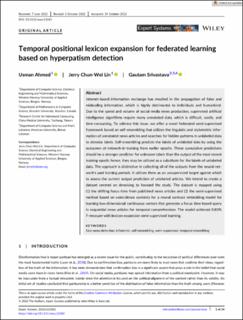| dc.contributor.author | Ahmed, Usman | |
| dc.contributor.author | Lin, Jerry Chun-Wei | |
| dc.contributor.author | Srivastava, Gautam | |
| dc.date.accessioned | 2023-04-04T09:24:42Z | |
| dc.date.available | 2023-04-04T09:24:42Z | |
| dc.date.created | 2022-12-14T09:46:51Z | |
| dc.date.issued | 2022 | |
| dc.identifier.citation | Expert systems. 2022:e13183. | en_US |
| dc.identifier.issn | 0266-4720 | |
| dc.identifier.uri | https://hdl.handle.net/11250/3062011 | |
| dc.description.abstract | Internet-based information exchange has resulted in the propagation of false and misleading information, which is highly detrimental to individuals and humankind. Due to the speed and volume of social media news production, supervised artificial intelligence algorithms require many annotated data, which is difficult, costly, and time-consuming. To address this issue, we offer a novel federated semi-supervised framework based on self-ensembling that utilizes the linguistic and stylometric information of annotated news articles and searches for hidden patterns in unlabeled data to denoise labels. Self-ensembling predicts the labels of unlabeled data by using the outcomes of network-in-training from earlier epochs. These cumulative predictions should be a stronger predictor for unknown labels than the output of the most recent training epoch; hence, they may be utilized as a substitute for the labels of unlabeled data. The approach is distinctive in collecting all of the outputs from the neural network's past training periods. It utilizes them as an unsupervised target against which to assess the current output prediction of unlabeled articles. We intend to create a dataset centred on denoising to forward the study. The dataset is mapped using (1) the shifting focus time from published news articles and (2) the semi-supervised method based on coincidence contexts for a neural contrast embedding model for learning low-dimensional continuous vectors that generate a focus time-based query in sequential news articles for temporal comprehension. The model achieved 0.83% F-measure with lexicon expansion semi-supervised learning. | en_US |
| dc.language.iso | eng | en_US |
| dc.publisher | Wiley | en_US |
| dc.rights | Navngivelse 4.0 Internasjonal | * |
| dc.rights.uri | http://creativecommons.org/licenses/by/4.0/deed.no | * |
| dc.title | Temporal positional lexicon expansion for federated learning based on hyperpatism detection | en_US |
| dc.type | Peer reviewed | en_US |
| dc.type | Journal article | en_US |
| dc.description.version | publishedVersion | en_US |
| dc.rights.holder | © 2022 The Authors. | en_US |
| dc.source.pagenumber | 14 | en_US |
| dc.source.journal | Expert systems | en_US |
| dc.identifier.doi | 10.1111/exsy.13183 | |
| dc.identifier.cristin | 2092873 | |
| dc.source.articlenumber | e13183 | en_US |
| cristin.ispublished | true | |
| cristin.fulltext | original | |
| cristin.qualitycode | 2 | |

